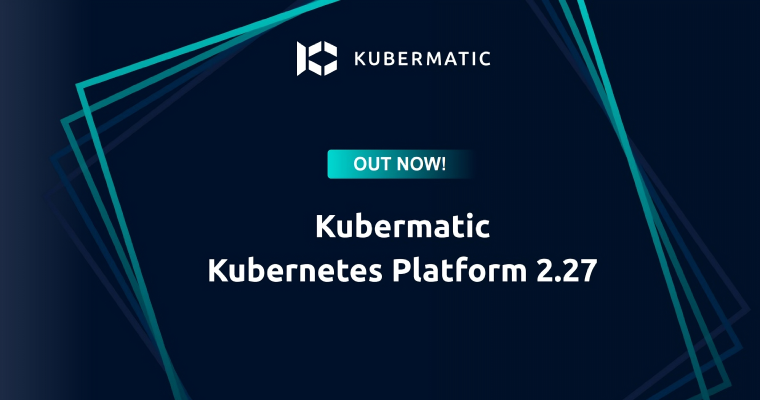
- Introduction
- Features
Freshly Released

Introducing KKP 2.27: AI Kit, Enhanced Backup Feature and more exciting advancements
Check out the latest features introduced in KKP 2.27, including AI Kit, enhanced backup feature and more.
Latest Features
AI Power for Infrastructure Operation
KKP leverages AI-driven automation with AI Kit for seamless deployment of AI, GenAI, and LLM workloads at scale, optimizing performance for both CPU and GPU. Additionally, K8sGPT is integrated as a default application and CLI tool within the web terminal, enhancing cluster debugging by bringing AI-powered insights closer to human understanding.
ExploreAutomated Kubernetes Backups
Leveraging Velero and the Kubernetes API, it ensures seamless backup, recovery, and migration across on-premises and cloud environments. With the latest KKP update, users can now restore cluster backups to a completely different KKP instance, providing greater flexibility for disaster recovery, environment transitions, or planned migrations.
Explore
Vanilla Kubernetes
- 100% kubernetes compliant
- Kubernetes version compliance within 4-6 weeks
- Support for Kubernetes 1.30, 1.31, and 1.32, enhancing security and stability.
Multi-tenant Architecture
- Separate cloud providers and preset environments by organizational units
- Datacenter separation – decide where the data is stored
- Multi-cluster separation lowers effort for in-cluster policy enforcement
- Support for Static Labels on Clusters that allows the tagging of immutable metadata to clusters, facilitating more consistent management across multi-cluster environments.
Identity and Access Management
- Streamline authentication and access control, user and team management, enterprise security and operational observability
- Deploy securely provisioned clusters with blueprints and presets to keep developers within company policies
- Audit Logging Webhook Backend for improved security and compliance monitoring, which allows routing of audit logs to external systems.
Automated kubernetes lifecycle management
- Provision, scale, update, and clean up of clusters with just an API call
- Automatic roll out and roll back of upgrades
- Templatized workflows for repetitive tasks
- Migration from Machine-Controller Userdata to OSM, which improves the management of OS-level configurations, resulting in smoother operations.
Backup & Recovery
- Centralized multi-cluster and multi-cloud backup handling- select from daily, weekly, monthly or customized as backup options
- Customizable backup locations - Multiple backup destinations from the UI Admin Panel
- Gzip Support for ETCD Snapshots, which optimizes backup storage by reducing the size of snapshots, speeding up the process.
- Enhanced Cluster Backup: Restore to different KKP instances for flexible recovery and migration.
Artificial Intelligence and GenAI for Infrastructure Operation
- Next Level Cluster Debugging with K8sGPT which has been integrated to KKP as a default application and also to the web terminal feature as a CLI tool.
- Effortless Nodes Management with NVIDIA GPU's and other specialized devices through Kubernetes' device plugin framework.
- Flexibility, Automation & Increased Efficiency: AI-Native Infrastructure Platform, specifically designed to utilize AIOps to ensure optimal operator and end-user experiences.
- AI Kit in KKP: Effortlessly deploy AI, GenAI, and LLM workloads with optimized performance for both CPU and GPU workloads. AI Kit simplifies running inference and fine-tuning machine learning models, supports multi-modal models, and provides air-gapped environment compatibility.
Free choice of infrastructure stack
- Native support of AWS, Azure, GCP, DigitalOcean, Alibaba Cloud, OpenStack, VMware, Bare Metal Provider Support with Tinkerbell Integration, and more
- Fast switching between clouds / on-prem by using one common default layer
Multi-cloud abstraction layer
- Abstract cloud dependencies from the cluster consumer using preset environments
- Centralized multi-cluster Logging, Monitoring, and Consumption Metering
Kubernetes Application Management
- Deploy any third-party application on a user cluster, with a few clicks
- After installation, applications can be reconciled to ensure reliability
- Default Applications Management for automatically installing preconfigured applications on new clusters, ensuring consistency and reducing setup time.
- Cluster Autoscaler as an Application for flexible scaling management.
Self-service portal
- Deliver Kubernetes-as-a-Service to end users
- Powerful & intuitive dashboard to visualize Kubernetes deployment
Open Policy Agent (OPA) with Gatekeeper
- Kubermatic OPA implementation offers experienced users complete control over OPA customization
- Constraint Templates are available for less experienced users to easily implement OPA
CNI: Choose or Bring your Own
- Users can choose between the two most popular CNIs: Canal and Cilium
- Additionally, users can simply add and manage a CNI of their choice
- Allow eBPF Proxy Mode When CNI is None, which adds flexibility for handling network traffic when a CNI is not needed.
Single Platform to Manage Virtual Machines on Bare-Metal
- Eliminate the need to run dedicated platforms to manage virtual machines on-premise
- Provision multiple kubernetes clusters on VMs on-premise with KubeVirt Cloud provider
- Single Namespace Mode for KubeVirt Provider, simplifying virtual machine (VM) management by reducing complexity in multi-namespace environments.
Complete Control Over Hybrid & Edge Deployments
- Operating System Manager (OSM) is responsible for creating and managing the required configurations for worker nodes in a Kubernetes cluster.
- Support for Enabling Cloud Drive on OpenStack VMs and Supporting VM Groups in vSphere for enhanced VM management in edge or hybrid environments.
Dual Stack Support
- Kubernetes resources can have both an IPv4 and IPv6 address.
Kubernetes Monitoring Tools
- Monitor health and resource consumption with built-in Prometheus and Grafana.
Full Lifecycle Management
- Upgrade your control plane and nodes without disruption and roll back as you need.
Integrated AddOn Controller
- Easily add any additional software, configuration, or policy into clusters.
- Automate Addon Maintenance, which ensures regular updates to add-ons without manual intervention, enhancing security.
Whitelabel with KKP
- Customize Kubermatic Kubernetes Platform to your brand and needs.
Platform communication
- Admin Announcement Feature: Broadcast messages for maintenance and updates.
If it works with kubernetes, it works with KKP!



